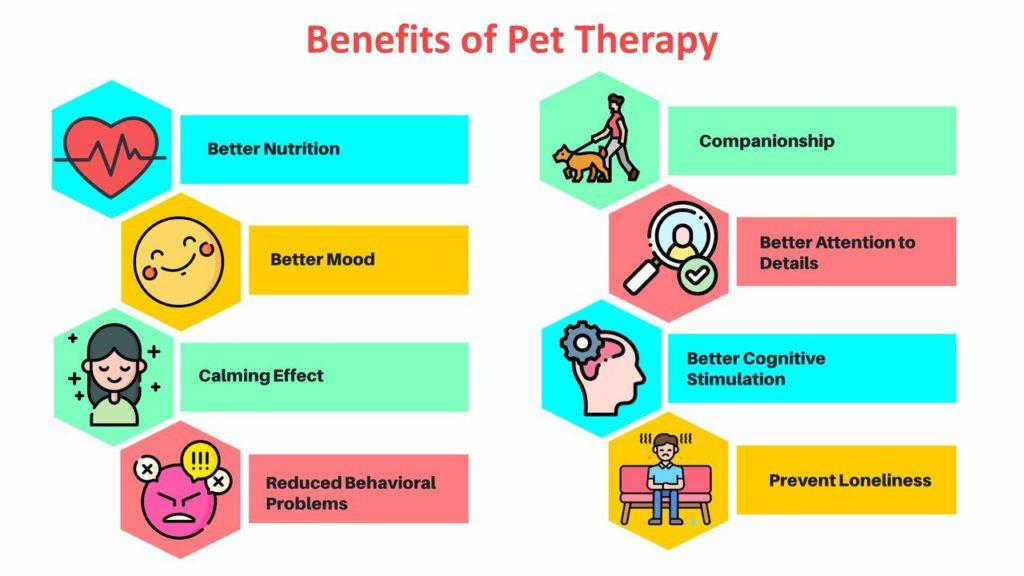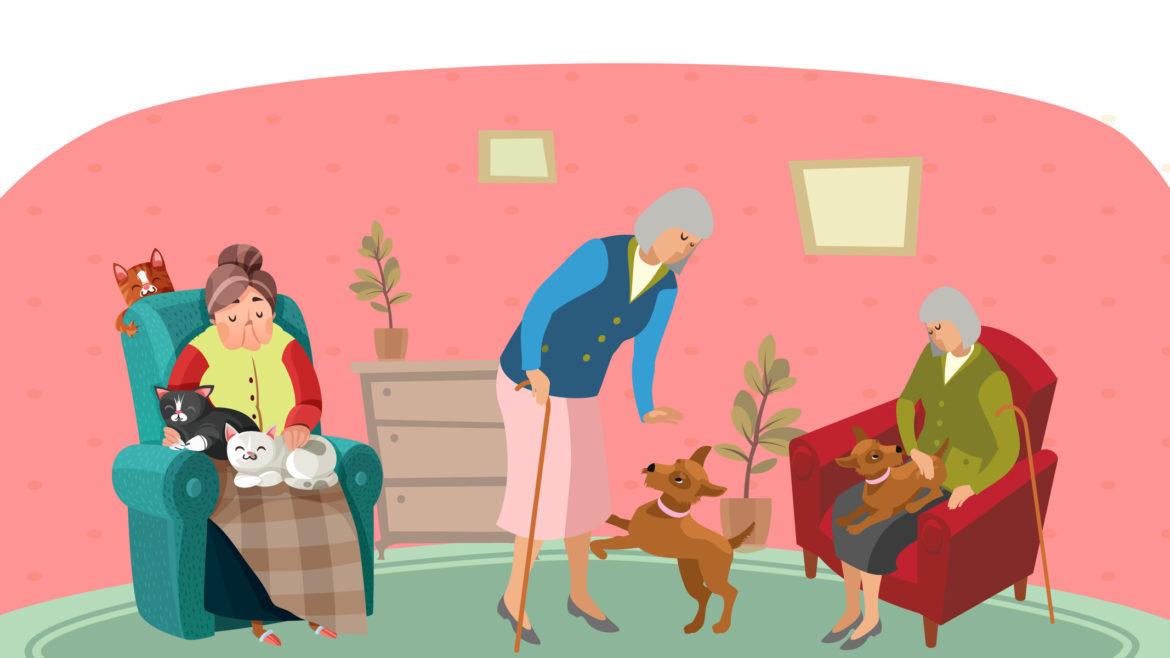Introduction
Mental health is extremely important. It is one of the most important aspects to ensure healthy and happy living. Various forms of therapy are performed to ensure that you stay healthy. Therapy has been one of the oldest practices. The development of awareness regarding mental health has managed to bring new forms of therapy to light.
Pet therapy is one of the most common forms of therapy and has been growing increasingly popular. It is a form of therapy that involves pets. Pet therapy in assisted living is a guided interaction between a person and a trained animal. It also involves the animal’s handler.
The purpose of pet therapy for assisted living is to help someone recover from or cope with health problems or mental disorders. Normally, dogs and cats are most commonly used for pet therapy. But, you could even use fish, pigs, and horses.
The animals chosen for pet therapy in assisted living depend on the goals of the person given therapy. It depends on the person and what outcome is expected to reach.
How Is Pet Therapy Used in Assisted Living?
Pet therapy is a low-stimulated form of therapy. It is normally given to adults or seniors living alone and suffering from drastic health conditions. The purpose of therapy varies from person to person. Pets are expected to be great mood boosters.
They provide comfort and tend to bring feelings of fulfillment. Pet therapy in assisted living ensures that the person’s mental health. This is especially true for those suffering from various disorders.
Scientifically it has been proven that pets do make one feel good. They are not only good for those who own pets but everyone around them. Animals are expected to make everyone much happier.
It doesn’t take a scientist to know that pets make humans feel good; anyone who’s ever stroked a dog’s fur or felt a cat’s thrumming purr knows this. Science can, however, tell us how and why pets can be therapeutic.
Research has shown how even bonding for 10 minutes can be a good mood booster. The animal fur is soft and provides comfort to many. Also, animals are more loyal than human beings.
So, if someone is recommended to get a pet, it can help them feel a sense of belonging. It brings in a feeling of belonging, which may be missing from the person’s life. Also, pets can help seniors from staying distracted.
It can provide them the opportunity of making the most of their time. If you have a pet around you, you can stay distracted, which may be an initial factor in feeling sick or ill.
Over the long term, pet and human interactions can lower cholesterol levels, fight depression. It may even help protect against heart diseases and stroke. This is why pets for the elderly can be so beneficial.
Pet Therapy’s Amazing Impact on Quality of Life
Pets impact the quality of human life. Firstly, it tends to bring in the joy which may be absent from a person’s life. For many people, the presence of a furry companion can change their entire life. Walking a dog or cat can be a great way to start the day.
It adds on a sense of purpose, but it will provide companionship, which is needed to ensure healthy living. This can even prevent feelings of loneliness and anxiety. Also, walking a cat or dog can be a great cardiovascular exercise.
It can help in minimizing the chances of a heart attack. A walk in the morning with your pet can even benefit your breathing capacities. Air can be soothing for lungs, especially the ones you breathe on morning walks. Pets can make the elderly feel needed, and that feeling can translate into a greater sense of purpose and self-worth.
During what can be a lonely time of life, the unconditional love of a cherished dog or cat can be a bridge to more socialization, lowered stress, mental stimulation, and a renewed interest in life.
Pets require many things from their owners, from food to exercise. These needs can give nursing home or adult day care residents a reason to get up and increase their physical activity. If someone feels shy or self-conscious about their decreased ability to do some of life’s daily activities. They once had learned about acceptance because the love of their pets is unconditional.
All of these things together can result in improved mental functioning for patients. This can even help in sharpening the memories of seniors who are looking after their pets. It has been proven that introducing pets into people’s lives reduces their risk of developing depression.
Animals stay longer than humans, and the best thing is how they are there constantly. If you have a pet, then you can only worry about looking after them. This could happen minus any negative information which your mind is busy processing.
It can even help you forget your condition and what it is that makes you upset. You can automatically feel that your life has gone excruciatingly busy.
Pet Therapy Impact on Sundowners Syndrome and Dementia
Pet therapy in assisted living has proven to be very efficient for those suffering from sundowners syndrome and dementia. It is one of the most powerful tools to prevent the development and even make sure you get healed on time.
It is an effective cure that requires to be dealt with bravely. Dementia and sundown syndrome are the most common forms of mental illness which develop in adults.
The initial cause of these syndromes and conditions is depression. One thing that pet therapy in assisted living does is that it removes loneliness. It prevents loneliness, especially when you know that you have someone to look after or someone who depends on you.
Pet therapy in assisted living for the elderly has also proven to be a powerful tool. It can be used against what’s known as “Sundowners Syndrome” evening periods of increased agitation and confusion. This is associated with Alzheimer’s. Animals’ non-verbal communication and profound acceptance can be soothing for those with difficulty. Some may even connect with memories of their treasured pets.
Scientists have proven that the most profoundly affected patients have improved. Their appetite, social interaction, tactile and cognitive stimulation improved after interactions with pets. Also, pets can be good at improving the mood and memory of all patients.
Pet therapy requires you to keep an eye on smaller parts of the pet. Your sense of attention to detail can improve. It makes sure that you are constantly paying attention to your surroundings. A guided sense of purpose can benefit you for a vast variety of reasons too.
It can automatically benefit the way you think. Whether it’s a big floppy dog, a bird, a cat, or even a fish aquarium, the benefits of having a pet for one with Alzheimer’s or other dementia are numerous.
Pets bring great benefits to all of us—companionship, unconditional love, and fun. By their very nature, pets do not judge, and they are not critical. Their very presence can help reduce the effects of dementia.
By their friendliness and non-threatening way, pets can help dementia patients be more interactive. Even if sometimes they cannot do so in social settings with other adults.
What Are the Benefits of Pet Therapy?
There are many benefits of pet therapy. There are ongoing therapy benefits. But pet therapy can be a real asset in curing various diseases. Some of the following benefits are:
1. Improves nutrition
Patients who have dementia need to have better food. Researchers have discovered that pet therapy in assisted living helps in improving nutrition. Also, if you surround your patients with fish aquariums, they will most likely eat more. Pet therapy increases food intake due to better moods and other areas of positivity.
2. Improved mood
The skin and fur of animals can be comfortable and soothing. Pets act like children, which could make you happy. Pets add joy to your life with their craziness and silliness. This could be a massive mood booster for many. Pets help perfect your mood. You can cuddle and even play with them, which could take away feelings of depression.
Multiple studies have cited benefits such as improved mood and more social interaction. Notable benefits since people with dementia are at risk for developing depression. This can further compromise their functioning and quality of life.
3. Calming effect
Are you feeling worried about something? Do you relatively suffer from anxiety? It has been proven that animals tend to add a soothing effect to the air. They tend to lighten the tension which exists in the room.
Animal presence lowers blood pressure levels down. Since their activities and playful nature adds joy to your life, they tend to make you calmer. Animals are loyal too, which makes you even calmer than before.
4. Decreased behavioral problem
Since pets tend to take away all the stress, you are in a better mood. Studies have shown that pets improve the behavior of those who live in community homes. They tend to make them less aggressive.
This is because they become much friendlier due to a better mood. Dogs and cats decrease challenging behavior in Alzheimer’s patients. It makes them calmer, and they tend to behave in much healthier ways.

5. Better cognitive stimulation
Pet therapy can provide better cognitive stimulation and improve overall brain health. Stroking a pet or playing with a dog can increase serotonin and dopamine levels, which are associated with happiness and stress relief. Pets provide us with a sense of purpose, encourage us to get outside and be active, and help us to form social connections. They can also help reduce anxiety and loneliness, providing a sense of companionship that is beneficial for mental health.
Pet Prep: How to Prepare Pets for Pet Therapy In Assisted Living?
Making your pet, an animal therapy perspective is not such a difficult task. It requires preparation and experience. To make your pet an animal therapy perspective, you must do a lot of things.
Firstly, you should start by making them extremely social. Prospective therapy animals need various experiences. From car rides to visiting with all kinds of people to going to as many settings as possible.
This might include activities like taking your dog to a public park, a garden center, and a pet store for dogs. Allow your pet to meet people of different ages, abilities, and ethnicities. This should also include individuals wearing uniforms, hats, masks, and glasses.
Therapy animals need to be at ease with physical contact. Start by touching their body everywhere, including feet, ears, tail, and mouth. Begin with a soft and gentle touch and work up to a slightly clumsy, but never painful, touch.
It’s especially important to start early with young animals. Still, older animals can benefit from this kind of exposure as well. Take your time and allow your pet to become comfortable with one thing before moving to the next stage.
You should now start working on developing a trusted relationship with your pets. Find things that make your pet even happier. Teach them new tricks. Take them out for walks.
Make the experience a large variety of things which they may enjoy and like. Make sure that you expose them to toys and play with them frequently. Also, take them to parks so that they learn how to play with others too.
Introduce them to strangers and let them play with strangers. Also, encourage your pet to make pet friends. Make sure they play with their pets too. The more exposure you give to your pets, the more they will be able to learn.
Conclusion
Pet therapy is the fastest cure for all kinds of diseases. They provide all levels of assistance to you. Everyone should consider Pet therapy for assisted living care. Especially senior community homes, which are prone to have seniors suffering from one thing to another. Old homes are pretty common places where depression develops. Community homes should bring in animals so that their residents can benefit in all ways. It will improve their emotional, mental, and health well-being.
If you need more help, BoomersHub is here to look after you and guide you throughout.
Frequently Asked Questions About Pet Therapy for the Elderly
How has pet therapy changed assisted living?
Pets provide a sense of companionship and promote socialization, which can improve overall quality of life for residents. In addition, pet therapy has been found to increase motivation, reduce anxiety, and encourage physical activity, as residents often take their pets for walks around the facility. As a result, pet therapy has helped to create a more positive and supportive environment for assisted living residents.
How does pet therapy help the elderly?
Pet therapy helps the elderly in many ways. That includes:
– Pets provide companionship and can help reduce loneliness in the elderly
– Pets can provide a sense of purpose and can help keep them active
– Pets can provide comfort and reduce stress levels in the elderly
– Pets can help promote socialization and interaction with others
– Pets promote cognitive stimulation and protect mental health of seniors
How can you test if pet therapy helps the elderly?
There are a few ways to test if pet therapy helps the elderly. One way is to compare the mental state of elderly people who receive regular pet therapy with those who do not. Another way is to measure how much medication elderly people taking part in pet therapy need versus those who do not. Also, look at how often elderly people with dementia experience agitation or aggression after starting pet therapy.

